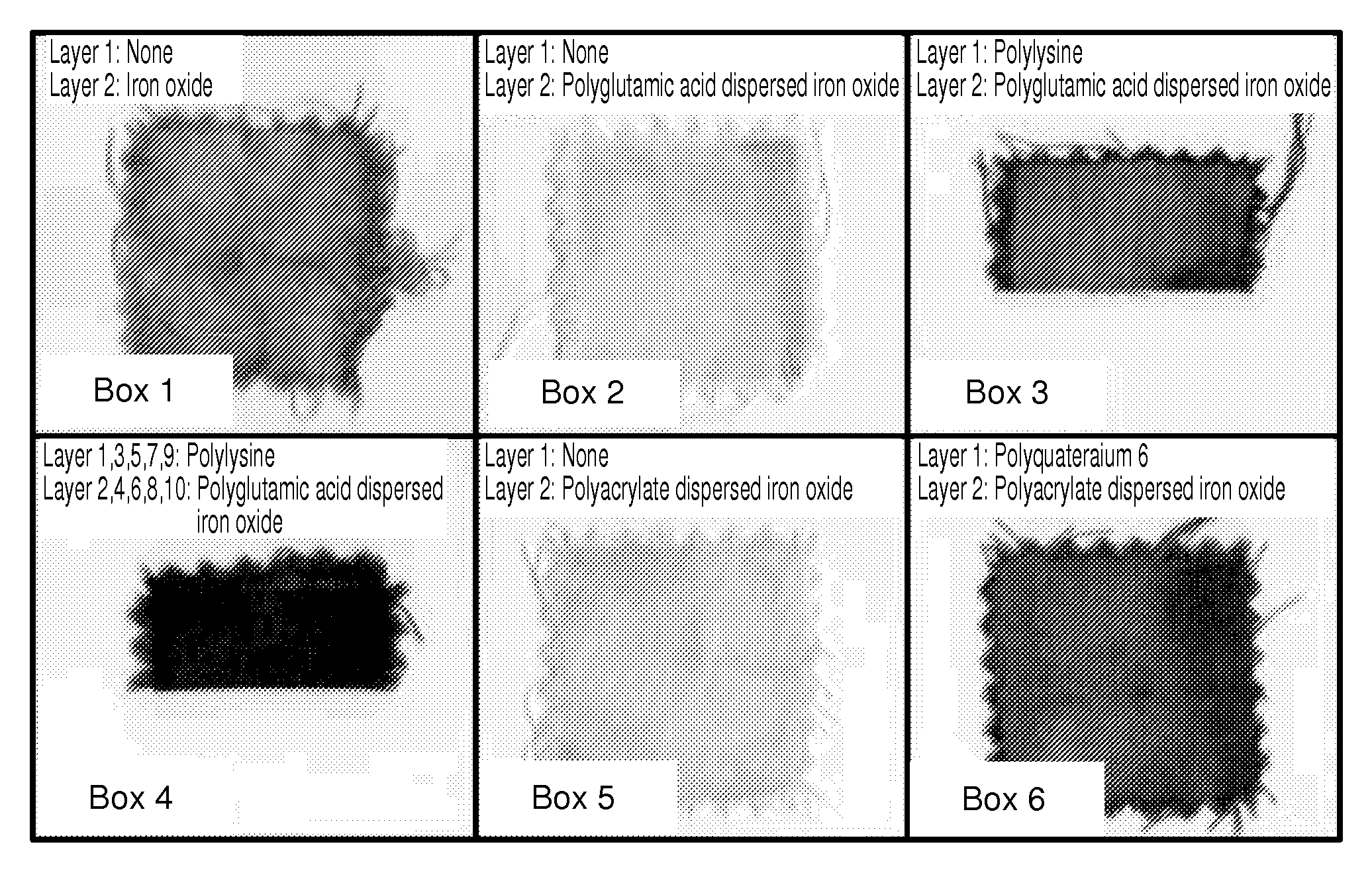Method of depositing particulate benefit agents on keratin-containing substrates
a technology of keratin-containing substrates and benefit agents, which is applied in the field of methods and kits for depositing particulate benefit agents, can solve the problems of large damage to the hair cuticle, hair breakage, and substantial damage to the hair of individuals using such dyes, and achieves enhanced benefits, enhanced color intensity, and improved resistance to washout
- Summary
- Abstract
- Description
- Claims
- Application Information
AI Technical Summary
Benefits of technology
Problems solved by technology
Method used
Image
Examples
example 1
[0092]Example 1 demonstrates the deposition of colored pigments on wool swatches according to the compositions and methods of this invention. Swatches of white wool fabric available from Testfabrics, Inc., as Style 541 Worsted Gabardine, Lot 5675 were treated with iron oxide under various conditions according to Table 6. Some of the swatches were also first treated with a composition containing a cationic compound according to the first composition of this invention, and, as a comparison, others were not. Photographs of the swatches are shown in FIG. 1.
TABLE 6FIG. 1SamplereferenceFirst compositionSecond composition1ABox 1NoneIron oxide1BBox 2NonePolyglutamic acid dispersediron oxide1CBox 3PolylysinePolyglutamic acid dispersediron oxide1DBox 4Polylysine X5Polyglutamic acid dispersediron oxide X51EBox 5NonePolyacrylate dispersed ironoxide1FBox 6Polyquaternium 6Polyacrylate dispersed ironoxide
[0093]All first compositions used in Example 1 contained 1 wt % of the cationic compound in DI...
example 2
[0095]Cationic peptides and proteins were assessed for iron oxide deposition and retention using the method described below. All of the cationic peptides and proteins were obtained from Sigma Aldrich of St. Louis, Mo.
[0096]The human hair used in this example was natural white hair in 250 mg tress samples. Such hair is available commercially, for example from International Hair Importers and Products (Bellerose, N.Y.), and is also available in different colors, such as brown, black, red, and blonde, and in various types, such as African-American, Caucasian, and Asian.
[0097]All colorimetric analyses were conducted using a Konic-Minolta colorimeter. The untreated hair tress samples used in this example were each analyzed colorimetrically before any treatment to obtain an untreated colorimetric measurement (Hunter L*, a*, b*).
[0098]Each cationic peptide or protein was formulated into a first treatment composition by weighing 0.05 mg of the peptide or protein into a scintillation vial to...
example 3
[0105]The five cationic peptides and proteins demonstrating the highest pigment deposition from Example 2 were further tested for color retention after multiple shampoos. The samples were prepared as in Example 2 above, except that 0.025 mg of each cationic peptide or protein was used in the first composition of each sample. The second treatment composition and the sequential application procedure were the same as described in Example 2.
Color Retention after Shampoo
[0106]About 12-24 hours after pigmenting the tresses, they were assessed for retention of color after shampooing. A 2% SLES solution was prepared by diluting RHODAPEX ES-2K sodium laureth sulfate (26%), available from Rhodia, Cranbury, N.J., in deionized water. Forty (40) grams of this solution was measured into a 4 ounce jar. The pigmented tress was added to the jar, and the jar was placed on an orbital shaker at 200 rpm for 5 minutes. The tress was then rinsed under running lukewarm tap water for about 30 seconds and ai...
PUM
| Property | Measurement | Unit |
|---|---|---|
| diameter | aaaaa | aaaaa |
| diameter | aaaaa | aaaaa |
| temperatures | aaaaa | aaaaa |
Abstract
Description
Claims
Application Information
 Login to View More
Login to View More - R&D
- Intellectual Property
- Life Sciences
- Materials
- Tech Scout
- Unparalleled Data Quality
- Higher Quality Content
- 60% Fewer Hallucinations
Browse by: Latest US Patents, China's latest patents, Technical Efficacy Thesaurus, Application Domain, Technology Topic, Popular Technical Reports.
© 2025 PatSnap. All rights reserved.Legal|Privacy policy|Modern Slavery Act Transparency Statement|Sitemap|About US| Contact US: help@patsnap.com


